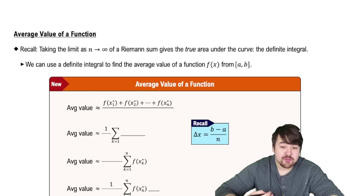Suppose that a function f(x) is defined for all real values of x except x=c. Can anything be said about the existence of limx→c f(x)? Give reasons for your answer.
Table of contents
- 0. Functions7h 54m
- Introduction to Functions16m
- Piecewise Functions10m
- Properties of Functions9m
- Common Functions1h 8m
- Transformations5m
- Combining Functions27m
- Exponent rules32m
- Exponential Functions28m
- Logarithmic Functions24m
- Properties of Logarithms36m
- Exponential & Logarithmic Equations35m
- Introduction to Trigonometric Functions38m
- Graphs of Trigonometric Functions44m
- Trigonometric Identities47m
- Inverse Trigonometric Functions48m
- 1. Limits and Continuity2h 2m
- 2. Intro to Derivatives1h 33m
- 3. Techniques of Differentiation3h 18m
- 4. Applications of Derivatives2h 38m
- 5. Graphical Applications of Derivatives6h 2m
- 6. Derivatives of Inverse, Exponential, & Logarithmic Functions2h 37m
- 7. Antiderivatives & Indefinite Integrals1h 26m
- 8. Definite Integrals4h 44m
- 9. Graphical Applications of Integrals2h 27m
- 10. Physics Applications of Integrals 3h 16m
- 11. Integrals of Inverse, Exponential, & Logarithmic Functions2h 31m
- 12. Techniques of Integration7h 41m
- 13. Intro to Differential Equations2h 55m
- 14. Sequences & Series5h 36m
- 15. Power Series2h 19m
- 16. Parametric Equations & Polar Coordinates7h 58m
1. Limits and Continuity
Introduction to Limits
Problem 2.2.59
Textbook Question
Limits of Average Rates of Change
Because of their connection with secant lines, tangents, and instantaneous rates, limits of the form limh→0 (f(x+h) − f(x)) / h occur frequently in calculus. In Exercises 57–62, evaluate this limit for the given value of x and function f.
f(x) = 3x - 4, x = 2
 Verified step by step guidance
Verified step by step guidance1
Identify the function f(x) = 3x - 4 and the point x = 2 where we need to evaluate the limit.
Substitute f(x) and f(x+h) into the limit expression: lim(h→0) [(f(x+h) - f(x)) / h]. This becomes lim(h→0) [(3(x+h) - 4) - (3x - 4)] / h.
Simplify the expression inside the limit: (3(x+h) - 4) - (3x - 4) simplifies to 3x + 3h - 4 - 3x + 4, which further simplifies to 3h.
The limit expression now becomes lim(h→0) [3h / h]. Simplify this expression by canceling h in the numerator and denominator, resulting in lim(h→0) [3].
Since the expression is now a constant, the limit as h approaches 0 is simply the constant value, which is 3.
 Verified video answer for a similar problem:
Verified video answer for a similar problem:This video solution was recommended by our tutors as helpful for the problem above
Video duration:
3mPlay a video:
Was this helpful?
Key Concepts
Here are the essential concepts you must grasp in order to answer the question correctly.
Limits
In calculus, a limit is a fundamental concept that describes the behavior of a function as its input approaches a certain value. It helps in understanding how functions behave near specific points, which is crucial for defining derivatives and integrals. The notation lim h→0 f(x+h) indicates examining the function f as the increment h approaches zero, allowing us to analyze instantaneous rates of change.
Recommended video:

One-Sided Limits
Average Rate of Change
The average rate of change of a function over an interval is calculated as the change in the function's value divided by the change in the input value. Mathematically, it is expressed as (f(b) - f(a)) / (b - a) for the interval [a, b]. This concept is essential for understanding how a function behaves over an interval and serves as a foundation for the more precise instantaneous rate of change, which is explored through limits.
Recommended video:

Average Value of a Function
Derivative
The derivative of a function at a point represents the instantaneous rate of change of the function with respect to its variable. It is defined as the limit of the average rate of change as the interval approaches zero, formally expressed as f'(x) = lim h→0 (f(x+h) - f(x)) / h. Derivatives are crucial in calculus for analyzing the behavior of functions, finding slopes of tangent lines, and solving optimization problems.
Recommended video:

Derivatives

 6:47m
6:47mWatch next
Master Finding Limits Numerically and Graphically with a bite sized video explanation from Patrick
Start learningRelated Videos
Related Practice
Textbook Question
